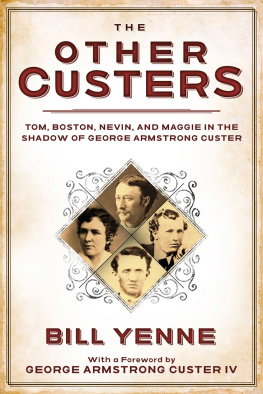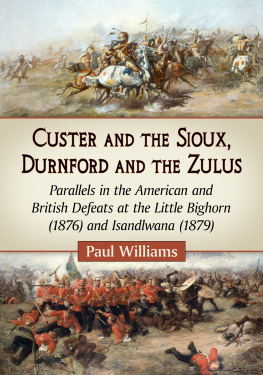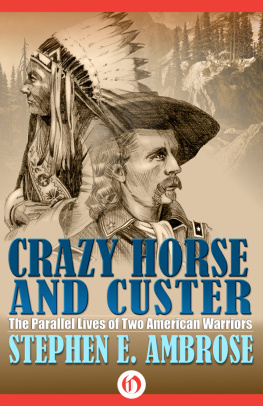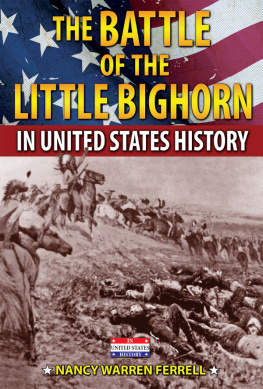
PETER THOMPSON'S ACCOUNT
IN THE MORNING before
mounting the companies form in
single lines. Each man,
commencing at the head of the
company calls out in turn his
number; one, two, three, four, and
so these are repeated until the
company is all numbered into sets
of fours. Cavalry men dismount
and fight on foot except when a
charge is made, but when a
dismount is ordered, number four
remains on his horse, numbers,
one, two, and three dismount and
hand their bridle reins to number
four who holds the horses, while
they deploy as skirmishers or as
otherwise directed. The men
composing the four with myself
were Fitzgerald [Pvt. John
Fitzgerald], Brennan [Pvt. John
Brennan], andWatson [Pvt.
James Watson], and although
composing one of the sets of fours
that entered into action
with Custer, not one of us ever reached the battlefield which
proved fatal to Custer and his
men.
Both Brennan and Fitzgerald tur
ned their horses toward the rear, when they had gone two miles beyond the lone teepee.
We soon gained the top of the bluffs where a view of the surrounding country was obtained. The
detail of Company F which was sent to investigate the teepee, now passed by us on their way to
the front with the report that it contained a dead Indian and such articles as were deemed
necessary for him on his journey to the "Happy Hunting Ground."
About a half a mile further on we came in sight of the Indian village and it was truly an
imposing sight to anyone who had not seen anything like it before. For about three miles on the left bank of the river the teepees were stretched, the white canvas gleaming in the sunlight.
Beyond the village was a black mass of ponies grazing on the short green grass.
When the companies came in sight of the village, they gave the regular charging yell and
urged their horses into a gallop. [Curleyand Foolish Elkalso reported that Custer's mencharged into a gallop when the Indian village came in sight.] At this time a detail of five
men from Company F was sent ahead to reconoiter and from this point I was gradually left
behind in spite of all I could do to keep up with my company. There were others also in the same fix. All urging on my part was useless. Getting vexed I dismounted and began to fasten on
my spurs, when I heard my name called and, on looking up, I saw Brennannear me on
horseback. He asked, "What is the matter?" I told him that I was afraid my horse wasentirely played out. "Well," said he, "Let us keep together." I straightened myself up and said,
"I will tell you what I will do." "I will trade horses with you if you will." He gave me a strange look and turned his horse around and rode towards the rear, leaving me to shift for myself.
"Well," I thought, "I will get along anyway." I finished putting on my spurs, mounted my horse again, and rode on after my company, but my progress was very slow.
My spurs having been poorly fastened came off again, and seeing a pair lying on the trail, I got
off my horse to secure them. Hearing an oath behind me, I looked back and saw my
comradeWatson trying to get his horse on its feet. The poor brute had fallen and was struggling to gain an upright position. [Note: the accounts of Arikara scouts Soldier and an Anonymous
Ree Scoutboth reported seeing Seventh Cavalry troopers kicking their downed horses just before the battle was about to begin.] Beside him, I saw Sergeant Finkle [Sgt. George A. Finckle] of our company sitting calmly on his horse looking on and making no effort to help Watson in his difficulty. But finally the poor animal gained his feet with a groan, and Finkle passed on with a rush to overtake our company. [Note: this was clearly the slow part of the troop -- Sgt.
Fincklehad already missed the chance to carry Custer's last order -- and live -- because his
mount was giving out.]
By this time, the last of the companies had disappeared over the crest of the hill. I was still
tugging away at the spurs, when Watson came up and asked what the trouble was and then
passed on in the trail of the soldiers. I mounted my horse again but found that a staggering walk was all I could get out of him.
I then looked across the river at the Indian Village, it was all in commotion. One party of Indians were dashing down the river; others were rushing toward the upper end of the village. The cause
of this commotion was Major Reno with three companies of men about a mile distant from the upper end of the village, dashing along in a gallop towards them. The officers were riding in
order, a little in advance of their respective companies. It was a grand sight to see those mencharging down upon the village of their enemies, who outnumbered them many times. The
well-trained horses were kept well in hand. There was no straggling; they went together,
neck and neck, their tails streaming in the wind, and the riders arms gleaming in the
sunlight. It was no wonder that the Indians were in great commotion when they beheld the
bold front presented by the cavalry. But alas! How deceptive are appearances. The cavalry
dashed into the village where one of the noncommissioned officers halted and struck up the
company's guidon alongside of a teepee before he was shot from his horse. The halt was but
for a moment, for the Indians came rushing towards them in great numbers. At this
juncture the dry grass caught on fire threatening the destruction of the village, but the
squaws fearless as the braves themselves fought the fire and tore down the teepees which
were in danger of burning. Major Reno seeing that he was greatly outnumbered ordered
an immediate retreat to a grove of cottonwood trees, which stood on the bank of the river
about a mile from the upper end of the village, where they found shelter for their horses
and protection for themselves...
* * *
Meanwhile, I was persuing my way along the trail on foot leading my horse for I was afraid he
would fall down under me, so stumbling and staggering was his gait.
After the disappearance of Custer and his men, I felt that I was in a terrible predicament to be left practically alone in an enemy's country, leading a horse practically useless.
While meditating upon the combination of circumstances which had brought me into this
unhappy condition, I looked ahead and saw Watson, but was unable to overtake him slow as he was going. He suddenly turned aside from the trail as if he wished to avoid some threatening
danger. While I was wondering what it :could be, I saw a small party of Indians, about thirty in
number driving a small bunch of ponies and mules, coming toward us. I thought my time had
surely come; It was too late to retreat.
While I was making calculations as to leaving my horse and trying my luck on foot, I thought I
was seeing something familiar in their appearance. On coming close, I saw they were our Ree
scouts and two Crow Indians, one of whom was Half Yellow Face or Two Bloody Hands. He had received this latter name from the fact that on the back of his buckskin shirt the print of two human hands was visible, either put there by red ink or blood.
Next page









